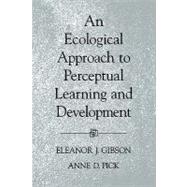
Note: Supplemental materials are not guaranteed with Rental or Used book purchases.
Purchase Benefits
Looking to rent a book? Rent An Ecological Approach to Perceptual Learning and Development [ISBN: 9780195165494] for the semester, quarter, and short term or search our site for other textbooks by Gibson, Eleanor J.; Pick, Anne D.. Renting a textbook can save you up to 90% from the cost of buying.
| 1 Historical Perspectives and Present-Day Confrontations | 3 | (11) | |
| 2 An Ecological Approach to Perceptual Development | 14 | (12) | |
| 3 Studying Perceptual Development in Preverbal Infants: Tasks, Methods, and Motivation | 26 | (19) | |
| 4 Development and Learning in Infancy | 45 | (7) | |
| 5 What Infants Learn About: Communication | 52 | (23) | |
| 6 What Infants Learn About: Interaction with Objects | 75 | (28) | |
| 7 What Infants Learn About: Locomotion and the Spatial Layout | 103 | (31) | |
| 8 The Learning Process in Infancy: Facts and Theory | 134 | (25) | |
| 9 Hallmarks of Human Behavior | 159 | (18) | |
| 10 The Role of Perception in Development beyond Infancy | 177 | (26) | |
| References | 203 | (24) | |
| Index | 227 |
The New copy of this book will include any supplemental materials advertised. Please check the title of the book to determine if it should include any access cards, study guides, lab manuals, CDs, etc.
The Used, Rental and eBook copies of this book are not guaranteed to include any supplemental materials. Typically, only the book itself is included. This is true even if the title states it includes any access cards, study guides, lab manuals, CDs, etc.